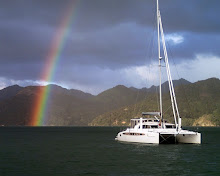





Puerto Escondido is a nearly landlocked harbor fourteen miles south of the town of Loreto. “The hidden port” features a small but modern marina and a large number of mooring balls that can accommodate over one hundred boats. It provides excellent protection from the winds and the seas that can make many portions of the Baja peninsula rolly and uncomfortable. The marina complex also features a small store, restaurant and cruiser club house with a large lending library and DVD exchange. We booked a one week stay on one of the secure moorings giving us the opportunity to catch up on a few boat projects and tour nearby Loreto and the surrounding area by rental car. Anne and friends were pleased to hear of a large, open-air produce market that operates every Sunday and a group of us combined a shopping run there with lunch at one of the town’s quaint restaurants. A few days later, while sharing a rental car with friends Howard and Lynn, we drove for nearly two hours up a steep road into the nearby Sierra Gigante mountains to visit a large Spanish mission built in the 1600’s. It was from this impressive facility that missionaries ventured north establishing the many missions that are currently found north of the border in California. Little else of interest was found in the small community near the mission and we found ourselves amazed that such a rugged remote location would have been chosen so many years ago. The next morning, Howard and Lynn joined us for an exploratory hike up a canyon near the harbor written about in John Steinbeck’s “Log of The Sea of Cortez”. What started as a hike quickly became a rock scramble and then a more serious climb requiring careful hand and foot placements. At times Mark wished he had brought one of his climbing ropes that he keeps aboard “Blue Rodeo” for ascending its mast. The beauty of the canyon was truly amazing and, even though it was the dry season, we could clearly imagine the raging torrents of water that sculpted the canyon during the summer thunderstorms.
One of the unexpected pleasures of our stay in Puerto Escondido was the opportunity to connect with three of Mark’s old friends from the Ventura marina. Anne and Jeff aboard “Outrider” and Ken aboard “Bungee” have been cruising Mexico for a number of years and were happy to answer many of our questions about their travels and favorite places. After an enjoyable stay in the area, we topped off our fuel tanks and headed east across the channel to the Bahia Marquer anchorage on Isla del Carmen. There we found the clearest, warmest water to date and, unfortunately, hundreds of pesky bees. While lounging in “Blue Rodeo’s” cockpit, we had to laugh at the irony of the first bees arriving while our stereo played the Beatles song “Let it Be”. From now on, in our minds, the word “Be” in the song title will always be spelled with two “e”s. The next day, after listening to weather forecasts that warned of possible strong northerly winds within two days, we studied the charts and agreed on a strategy to move along to another anchorage better suited for north wind protection. As we conclude this blog entry, we are anchored off the town of Loreto itself where we will visit the produce market one last time tomorrow morning before continuing up the coast. The wind is currently blowing from the south and we find ourselves rocking and rolling a bit with no protection from that direction. We’ll see what the rest of the night has in store for us.



















